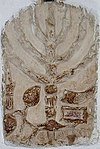Peki'in Synagogue
| Peki'in Synagogue | |
|---|---|
 | |
| Religion | |
| Affiliation | Judaism |
| Year consecrated | 1873 |
| Location | |
| Location | Peki'in |
The Peki’in Synagogue (בית הכנסת העתיק בפקיעין), is a synagogue located in the centre of Peki'in, Northern Israel. The current building was erected in 1873, on the site of older ones. Local tradition holds that it has two stones taken from the walls of the Jewish Temple in Jerusalem built into its walls.[citation needed]
The synagogue, not usually active as of 2005, is kept by Margalit Zinati (born 1931). Zinati is member of a Jewish family who have lived for centuries in Peki’in, reportedly since the time of the Second Temple.[1] Margalit Zinati, the last Jewish woman in Peki'in, was honoured for her work at the 70th [[Independence Day (Israel) Independence Day]] in 2018, and her family home is run as a heritage site by the Education Department of the World Zionist Organization (WIZO).[2]
Tradition[]
According to local tradition, the synagogue was built on the site of the beth midrash (religious school) where Rabbi Joshua ben Hananiah has taught before the Bar Kokhba war, and Rabbi Shimon bar Yochai after it.[citation needed] There is dissent among scholars on whether the cave and town known from the life story of Shimon bar Yochai can be identified with modern Peki’in.[3]
Research[]

The current structure dates from 1873 after the former one was destroyed by an earthquake 30 years earlier.[citation needed] Funding for the construction, attested to on a plaque commemorating the donation, was given by a Jew named Rafael Halevy from Beirut.[citation needed]
Carved stones from ancient synagogue[]
In 1926 and 1930[citation needed] two old stone tablets were uncovered, reused in the walls of the modern synagogue.[4] One depicts a menorah flanked by a lulav, etrog, shofar, and incense shovel.[4] The second one, of higher craftsmanship, depicts a Torah shrine.[4] A third stone contains a fragmentary relief of a grapevine, found in secondary use in a modern village house.[4] All three have been dated between the late 2nd century CE and the early 3rd.[4] It has been suggested that the second stone may have come from another, now disappeared Galilean synagogue from Khirbet Tiriya or Tiriha.[4] Further decorated stones believed to originate from an ancient synagogue were reused in modern buildings from Peki'in.[4] The 2nd-3rd century date for the main three decorated stones is based on a publication by Eliezer Sukenik from 1931 and a gazetteer by from 1977.[4]
Ancient inscriptions[]
In February 2017, the Council for Conservation of Heritage Sites in Israel uncovered an 1800 year old limestone capital. Engraved on it are two Hebrew inscriptions dating to the Roman period. The column was found upside down in the building's courtyard. According to the IAA's regional inspector, "A preliminary analysis of the engravings suggests that these are dedicatory inscriptions honoring donors to the synagogue." Uriel Rosenboym, director of Beit Zinati (the Jewish heritage site run by the World Zionist Organization), exclaimed that "No one can argue with the written artifact. There was an ancient synagogue here and the synagogue was built in its current form in recent centuries."[5][6]
Public awareness[]
In 1922 Yitzhak Ben-Zvi visited the Jewish community of Peki’in[7] and documented it in his book Shaar Yashuv.[citation needed]
In 1955 the Israeli Ministry of Religious Affairs renovated the building at the request of by then president Yitzhak Ben-Zvi.[7]
The Second Series of the Israeli new sheqel (NIS), put in circulation in 1999, features on the 100 NIS banknote a portrait of Ben-Zvi (front), and the Peki’in synagogue along with a view of the village (back).[8]
References[]
- ^ "Cities: Peki'in (Buke'a)". ThinkIsrael.com/ (Israel Ministry of Tourism). Archived from the original on 2007-10-08. Retrieved 2007-07-04.
- ^ "Event in honor of Ms. Margalit Zinati". Jerusalem: The Education Department of the World Zionist Organization. 2018. Retrieved 23 April 2021.
- ^ "1,800-year-old Hebrew Donor Plaques Found in Synagogue in Northern Israel". Ruth Schuster for Haaretz. Tel Aviv. 22 February 2017. Retrieved 23 April 2021.
- ^ Jump up to: a b c d e f g h Segal Chiat, Marilyn Joyce (1982). Handbook of Synagogue Architecture (reprint, Brown University, Brown Judaic Studies (Number 29), 2020 ed.). Scholars Press. pp. 53–54, 61. doi:10.2307/j.ctvzpv521. ISBN 978-0-89130-524-8. Retrieved 24 April 2021.
- ^ "Israel Antiquities Authority". www.antiquities.org.il (in Hebrew). Retrieved 2017-02-21.
- ^ "1,800-year-old Hebrew stone inscriptions found in ancient Galilee synagogue". The Jerusalem Post | JPost.com. Retrieved 2017-02-21.
- ^ Jump up to: a b "Researchers race to document vanishing Jewish heritage of Galilee Druze village". Eli Ashkenazi for Haaretz. Tel Aviv. 25 July 2012. Retrieved 23 April 2021.
- ^ "Second Series of the New Sheqel: NIS 100". Bank of Israel. Retrieved 2021-04-23.
Further reading[]
| Wikimedia Commons has media related to Old Synagogue (Peqi'in). |
- I. Ben-Zevi. "Discoveries at Pekiin." Palestine Exploration Fund Quarterly Statement, 62(4), pp. 210–214. doi:10.1179/peq.1930.62.4.210
- E. L. Sukenik. "Designs of the Torah Shrine in Ancient Synagogues in Palestine." Palestine Exploration Fund Quarterly Statement, 63(3), pp. 22–25. doi:10.1179/peq.1931.63.1.22
Coordinates: 32°58′39″N 35°20′08″E / 32.977499°N 35.335564°E
- Ancient synagogues in the Land of Israel
- Buildings and structures in Northern District (Israel)
- 1873 establishments in Ottoman Syria
